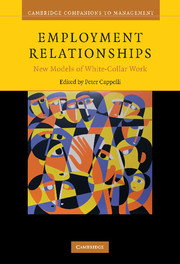Book contents
- Frontmatter
- Contents
- List of figures
- List of tables
- List of contributors
- Foreword
- 1 Introduction
- 2 Corporate restructuring and the employment relationship
- 3 The up and out in organizations
- 4 In the pursuit of quality and quantity: the competing demands in call centers
- 5 Three's a crowd? Understanding triadic employment relationships
- 6 The changed world of large law firms and their lawyers: an opportune context for organizational researchers
- 7 The upside of bureaucracy: unintended benefits for professional careers
- Index
- References
2 - Corporate restructuring and the employment relationship
Published online by Cambridge University Press: 02 December 2009
- Frontmatter
- Contents
- List of figures
- List of tables
- List of contributors
- Foreword
- 1 Introduction
- 2 Corporate restructuring and the employment relationship
- 3 The up and out in organizations
- 4 In the pursuit of quality and quantity: the competing demands in call centers
- 5 Three's a crowd? Understanding triadic employment relationships
- 6 The changed world of large law firms and their lawyers: an opportune context for organizational researchers
- 7 The upside of bureaucracy: unintended benefits for professional careers
- Index
- References
Summary
Introduction
Widespread corporate restructuring has transformed employment relationships in numerous lasting ways in recent decades, as the process of corporate reduction in force (RIF) ended the careers of many employees and corporate reorganization changed the way managers are evaluated and rewarded (see Cappelli et al., 1997). Scholarly interest in understanding this transformation process has led to the creation of a wealth of knowledge on employment change from a number of academic disciplines. Economists have analyzed changes in tenure with a firm along age, sex, occupation, and industry lines, showing that – in stark contrast to previous temporary layoffs, which tended to be limited to blue-collar employees – terminations during RIF are now permanent and disproportionately affect previously protected groups such as middle-aged managers in manufacturing firms (Baumol, Blinder, and Wolff, 2003). Psychologists have studied the negative effects of restructuring on employees who remain in restructured firms, demonstrating that survivors of RIF often responded with reduced morale and work effort (Brockner et al., 1992). Further, sociologists have examined broad patterns of career mobility, finding that restructuring spurred the movement of employees across organizations and industries (DiPrete, 1993).
Despite the clear effects of restructuring on the employment relationship, our understanding of the upward career mobility patterns of managers in restructured firms is surprisingly limited.
- Type
- Chapter
- Information
- Employment RelationshipsNew Models of White-Collar Work, pp. 31 - 64Publisher: Cambridge University PressPrint publication year: 2008
References
- 1
- Cited by



